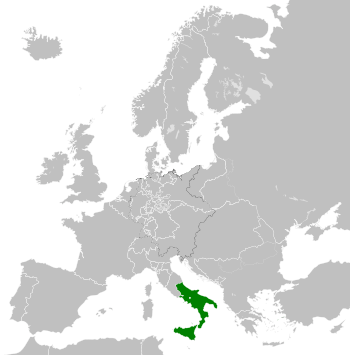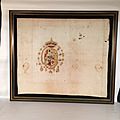Kingdom of the Two Sicilies facts for kids
Quick facts for kids
Kingdom of the Two Sicilies
Regno delle Due Sicilie
|
|||||||||||
|---|---|---|---|---|---|---|---|---|---|---|---|
| 1816–1861 | |||||||||||
|
|
|||||||||||

Location of the Kingdom of the Two Sicilies within Europe in 1839.
|
|||||||||||
| Capital | Palermo (1816–1817) Naples (1817–1861) |
||||||||||
| Religion | Roman Catholicism | ||||||||||
| Government | Absolute monarchy (1816–1848; 1849–1861) Constitutional monarchy (1848–1849) |
||||||||||
| King | |||||||||||
|
• 1816–1825
|
Ferdinand I (first) | ||||||||||
|
• 1859–1861
|
Francis II (last) | ||||||||||
| History | |||||||||||
|
• Edict of Ferdinand IV of Naples
|
12 December 1816 | ||||||||||
| 5 May 1860 | |||||||||||
| 17 March 1861 | |||||||||||
| Area | |||||||||||
| 1860 | 111,900 km2 (43,200 sq mi) | ||||||||||
| Population | |||||||||||
|
• 1860
|
8,703,000 | ||||||||||
|
|||||||||||
| Today part of | |||||||||||
The Kingdom of the Two Sicilies was the largest country in Italy before it became one united nation. It was created by joining the Kingdom of Sicily and the Kingdom of Naples. These two areas had been known as the "Two Sicilies" for a long time.
This kingdom existed from 1816 until 1861. In 1861, it joined with the Kingdom of Sardinia to form the Kingdom of Italy. The main cities of the Two Sicilies were Naples and Palermo. The kingdom covered the southern part of mainland Italy, called the Mezzogiorno, and the island of Sicily.
When the Kingdom of the Two Sicilies joined Italy, Naples and Southern Italy faced many changes. Poverty became a big problem. Because of this, thousands of people left their homes. They hoped to find a better life in other parts of the world, especially in the Americas.
The kingdom mostly relied on farming. Like other Italian states, a lot of the land was owned by the church. By 1750, the church owned between 50% and 65% of all the land.
Contents
How the Kingdom Started
The Kingdom of the Two Sicilies came from two older kingdoms: the Kingdom of Sicily and the Kingdom of Naples. These two had been separate since 1282. In 1442, King Alfonso V of Aragon brought them together.
However, after King Alfonso died in 1458, the kingdoms split again. His brother, John II of Aragon, ruled Sicily. His son, Ferdinand, became King of Naples.
Later, in 1501, King Ferdinand II of Aragon conquered Naples. This reunited the two kingdoms under the Spanish throne. They stayed united until the War of the Spanish Succession ended in 1713. After this war, Sicily was given to the Duke of Savoy. Naples went to Emperor Charles VI in 1714. In 1720, Sicily and Sardinia were swapped, bringing Naples and Sicily together again.
The Bourbon Rulers
In 1734, Charles, Duke of Parma, who was the son of Philip V of Spain, took control of Sicily from the Austrians. He became King Charles VII & V. In 1759, Charles became King of Spain. He then gave Sicily and Naples to his younger son, Ferdinand. This Ferdinand was crowned Ferdinand I of the Two Sicilies in 1816.
The Bourbon family ruled the Kingdom of the Two Sicilies for a long time. There was a short break when Napoleon took control.
Napoleon's Influence
In 1799, Napoleon Bonaparte captured Naples. He created a new state called the Parthenopaean Republic, which was controlled by France. King Ferdinand had to flee from Naples to Sicily. He stayed in Sicily until June of that year.
In 1806, Napoleon, who was now the French Emperor, removed King Ferdinand from power again. Napoleon made his brother, Joseph Bonaparte, the King of Naples. In 1808, Napoleon moved Joseph to Spain. He then appointed his brother-in-law, Joachim Murat, as King of the Two Sicilies. However, Murat only controlled the mainland part of the kingdom. During this time, King Ferdinand remained in Sicily, with Palermo as his capital city.
After Napoleon's defeat, the Congress of Vienna in 1815 brought King Ferdinand back to power.
The End of the Kingdom
There were several uprisings in Sicily against King Ferdinand II. He ruled from 1830 to 1859. But the kingdom truly ended in 1860. This happened during the Expedition of the Thousand.
This expedition was led by Garibaldi. He was a very important figure in uniting Italy. Garibaldi had the support of the House of Savoy and their Kingdom of Piedmont-Sardinia.
Garibaldi's army quickly defeated the Sicilian forces. After capturing Palermo and Sicily, Garibaldi moved towards Naples. The final battles took place at Volturnus in 1860 and at the siege of Gaeta. King Francis II had gone to Gaeta, hoping for help from France, but it never came.
The last cities to resist Garibaldi were Messina and Civitella del Tronto. They surrendered on March 13 and March 20, 1861. The Kingdom of the Two Sicilies was dissolved. Its land became part of the new Kingdom of Italy, which was founded in the same year. The story of the fall of the Sicilian noble families during Garibaldi's invasion is told in the novel The Leopard by Giuseppe Tomasi di Lampedusa and its film.
Images for kids
-
Cappella Palatina, church of first unifier Roger II of Sicily.
-
Portrait of Ferdinand II, 1844
-
The Teatro Reale di San Carlo in Naples 1830 as rebuilt after the 1816 fire
-
Silver coin: 120 grana Ferdinando II - 1834
-
Contadini from the Neapolitan countryside by Filippo Palazzi, 1840
-
Ferdinand I, 1816–1825
-
Francis I, 1825–1830
-
Ferdinand II, 1830–1859
See also
 In Spanish: Reino de las Dos Sicilies para niños
In Spanish: Reino de las Dos Sicilies para niños






















